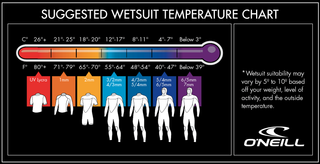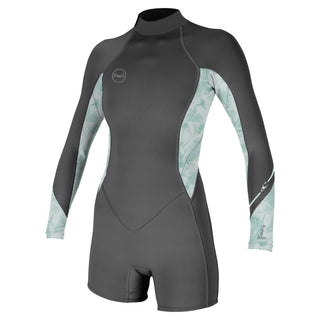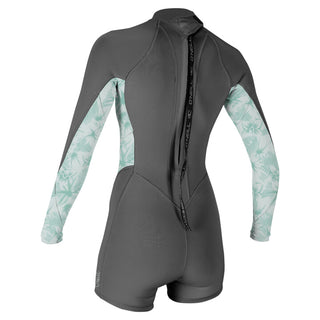With hundreds of O'Neill wetsuit combinations to pick from, it can seem a little overwhelming to choose a wetsuit that’s right for you. A solid starting point for an informed decision is the expected water temperature that you’ll be using your suit in, but you can't discount a range of other factors that come into play when buying a wetsuit. So, how do you choose a wetsuit? Let's break it all down in our simple wetsuit guide.
SEASONSWetsuit styles and neoprene thicknesses are often placed in season categories, since seasons are usually directly related to water and air temperature. Summer means thinner wetsuits and more skin exposed, while winter calls for thicker neoprene and way more body coverage. Spring and fall are a bit less straightforward and depend more on personal preference, especially if you're opting for one wetsuit to bridge multiple seasons. A typical (European) wetsuit quiver would consist of:A full spring suit, either 4/3 or 3/2, with style depending on preference and sport,A short arm summer suit, either 3/2 or 2/2, with short legs if water temperature permits,A 3/2 short arm fall suit, while surfers might prefer a version with long arms and short legs,A full winter suit, either 4/3 or 5/4, depending on water temperature and wind chill factor.
With a wide range of styles and neoprene thicknesses in your quiver, you’ll have a suit that fits your needs in any weather, any water temperature, on any given day. If you intend to buy just one wetsuit to start with, invest in one that will suit the widest range of seasons. Being too warm can be just as uncomfortable as being too cold, but remember that failing to protect yourself from cold is a dangerous risk to take, potentially resulting in hypothermia.
WATER TEMPERATURE & WIND CHILL FACTOR
In most circumstances water temperature will be the deciding factor in how to choose a wetsuit, but the so-called wind chill factor is equally important. The longer your body is above water and the more of your body that’s exposed, the more significant the wind chill factor becomes.
With surfing and bodyboarding, your body will be mostly in the water, while in sports like wind-surfing, kitesurfing and paddleboarding you'll be out of the water most of the time. So a surfer will probably prefer a thicker wetsuit in cold water temperatures and warmer air temperatures, while a windsurfer would choose a thinner wetsuit with short arms for the same conditions. Similarly, if the water is warm and the air temperature low, a surfer might choose a short legged version, while a windsurfer might prefer a suit with full legs. Check out the water temperature chart below and adjust the thickness and body style of your wetsuit according to its intended use and the expected wind chill factor.
HOW TO CHOOSE MY WETSUIT
All the above guidelines are just that: guidelines. Conditions and uses differ, but personal preference is a huge factor in choosing the right suit for you. When buying your first wetsuit you might not have strong feelings about any particular style, but the more time you spend in the water, the more you'll notice what you do and don't like. Although body styles are directly related to all sorts of weather conditions, they still leave enough room for interpretation. Some of us like the feel of the wind on our arms, while others feel more comfortable packed up in as much neoprene as possible. Just like body styles can differ, front versus back zips are often times a personal preference too. If you read through our whole wetsuit buying guide, you've already done all the important research on how to buy a wetsuit. At this point all that separates you from your perfect suit is a few easy steps:
Decide which activity you want a wetsuit for,Consider the most likely conditions you’ll be wearing your wetsuit in,Keep in mind personal preferences and comfort level, and to what degree they might influence your final choice,Determine your perfect size, using our size chart,Set a budget,Visit the wetsuit page, adjust the filters, choose your wetsuit, select the right size, and put in your order!

O’Neill BAHIA 2/1mm L/S Spring HY8
- Unit price
- /per
O'Neill Bahia is designed for a new generation of athletes that want to bring beauty, personality, and confidence to the water. The combination of chic styling and absolute function makes Bahia a unique wetuit line for the style-savvy and performance-driven athlete.

Hand washing

Do not iron

Do not tumble dry

No hot water

No dry cleaning
Adding product to your cart
With hundreds of O'Neill wetsuit combinations to pick from, it can seem a little overwhelming to choose a wetsuit that’s right for you. A solid starting point for an informed decision is the expected water temperature that you’ll be using your suit in, but you can't discount a range of other factors that come into play when buying a wetsuit. So, how do you choose a wetsuit? Let's break it all down in our simple wetsuit guide.
SEASONSWetsuit styles and neoprene thicknesses are often placed in season categories, since seasons are usually directly related to water and air temperature. Summer means thinner wetsuits and more skin exposed, while winter calls for thicker neoprene and way more body coverage. Spring and fall are a bit less straightforward and depend more on personal preference, especially if you're opting for one wetsuit to bridge multiple seasons. A typical (European) wetsuit quiver would consist of:A full spring suit, either 4/3 or 3/2, with style depending on preference and sport,A short arm summer suit, either 3/2 or 2/2, with short legs if water temperature permits,A 3/2 short arm fall suit, while surfers might prefer a version with long arms and short legs,A full winter suit, either 4/3 or 5/4, depending on water temperature and wind chill factor.
With a wide range of styles and neoprene thicknesses in your quiver, you’ll have a suit that fits your needs in any weather, any water temperature, on any given day. If you intend to buy just one wetsuit to start with, invest in one that will suit the widest range of seasons. Being too warm can be just as uncomfortable as being too cold, but remember that failing to protect yourself from cold is a dangerous risk to take, potentially resulting in hypothermia.
WATER TEMPERATURE & WIND CHILL FACTOR
In most circumstances water temperature will be the deciding factor in how to choose a wetsuit, but the so-called wind chill factor is equally important. The longer your body is above water and the more of your body that’s exposed, the more significant the wind chill factor becomes.
With surfing and bodyboarding, your body will be mostly in the water, while in sports like wind-surfing, kitesurfing and paddleboarding you'll be out of the water most of the time. So a surfer will probably prefer a thicker wetsuit in cold water temperatures and warmer air temperatures, while a windsurfer would choose a thinner wetsuit with short arms for the same conditions. Similarly, if the water is warm and the air temperature low, a surfer might choose a short legged version, while a windsurfer might prefer a suit with full legs. Check out the water temperature chart below and adjust the thickness and body style of your wetsuit according to its intended use and the expected wind chill factor.
HOW TO CHOOSE MY WETSUIT
All the above guidelines are just that: guidelines. Conditions and uses differ, but personal preference is a huge factor in choosing the right suit for you. When buying your first wetsuit you might not have strong feelings about any particular style, but the more time you spend in the water, the more you'll notice what you do and don't like. Although body styles are directly related to all sorts of weather conditions, they still leave enough room for interpretation. Some of us like the feel of the wind on our arms, while others feel more comfortable packed up in as much neoprene as possible. Just like body styles can differ, front versus back zips are often times a personal preference too. If you read through our whole wetsuit buying guide, you've already done all the important research on how to buy a wetsuit. At this point all that separates you from your perfect suit is a few easy steps:
Decide which activity you want a wetsuit for,Consider the most likely conditions you’ll be wearing your wetsuit in,Keep in mind personal preferences and comfort level, and to what degree they might influence your final choice,Determine your perfect size, using our size chart,Set a budget,Visit the wetsuit page, adjust the filters, choose your wetsuit, select the right size, and put in your order!



